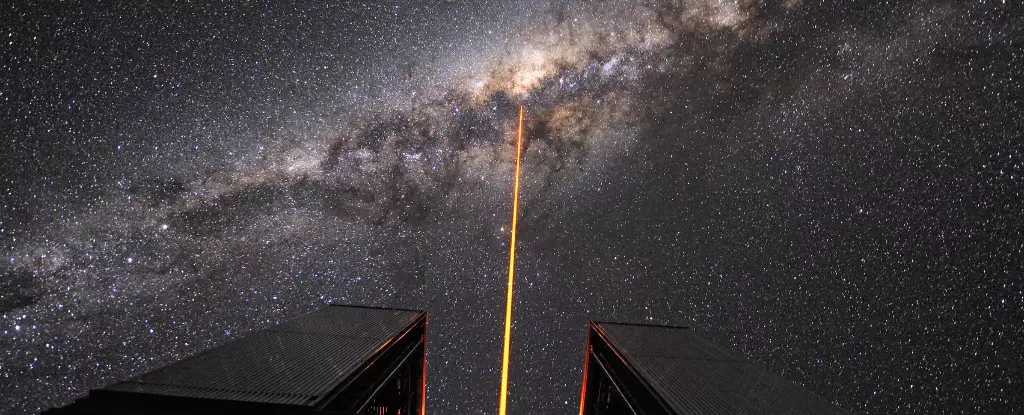Nestled in the core of the Milky Way lies a supermassive black hole known as Sagittarius A*, located approximately 27,000 light years from Earth. Spanning about 23.5 million kilometers in diameter, this enigmatic cosmic entity has long fascinated astronomers and led to numerous inquiries regarding its nature and influences. Recent research led by Florian Peißker and a team from the University of Cologne has unveiled a groundbreaking discovery: a binary star system orbiting Sagittarius A*. This finding not only marks a significant first for astronomy but also shines a light on a longstanding mystery about hypervelocity stars—those that traverse the galaxy at astonishing speeds.
A binary star system consists of two stars gravitationally bound to one another, orbiting around a common center of mass. While our Sun exists in isolation, the majority of stars in the Milky Way inhabit binary systems or even larger groupings, a property that has substantial implications for their behavior and life cycles. Approximately two-thirds of the stars in our galaxy are solitary, while the remaining third are grouped in binary or multiple configurations. Importantly, larger stars show a higher propensity to form these pairs.
Binary systems provide critical insights for astronomers. By observing the motion of these stars, researchers can extract valuable data regarding their properties—specifically, their masses. In solitary stars, mass estimations usually rely on luminosity; however, the dynamics of binaries afford a more direct approach, helping astronomers delve deeper into stellar evolution and formation.
The detection of this binary star system near Sagittarius A* posed significant technical challenges, as the vast distances involved prevented traditional observational tactics. Instead, the researchers employed the sophisticated instruments of the European Southern Observatory’s Very Large Telescope. By analyzing the Doppler effect—essentially the change in frequency or wavelength of light caused by the motion of the stars—the team identified a distinctive wobble in the light emitted from the stars, confirming their orbital relationship.
More remarkably, through their calculations, the astronomers established that this binary system is about 2.7 million years old, indicating that these stars ignited long before their introduction into the tumultuous environment surrounding the black hole. Such insights not only enrich our understanding of stellar life spans but also hint at the gravitational influences at play within such extreme gravitational fields.
The situation surrounding Sagittarius A* can be likened to our own Earth-Moon-Sun dynamic, where gravitational forces govern the motion of celestial objects. This analogy sheds light on how binary systems may contribute to the complexities of stellar orbits within gravitational fields. The stability observed in our solar system arises from significant distance disparities between the Sun and the Earth-Moon pair, forming a stable dynamic.
However, systems involving more complex interactions can lead to unpredictable ejections of stars from their established orbits—an event that might account for the mystery of hypervelocity stars. These extraordinary stars, traveling at velocities exceeding 1,000 kilometers per second, were previously thought to stem from binary systems orbiting supermassive black holes, only to be dislodged during close encounters as they navigated gravitational tumult.
The prevailing theory suggests that these hypervelocity stars were once part of binary systems that experienced gravitational interactions with Sagittarius A*. Over time, such stars can be flung into deep space, leaving our galaxy’s center. They emerge as hypervelocity stars, racing through the cosmos with remarkable speed. Observations linking these stars’ trajectories to the central black hole bolster this hypothesis, painting a cohesive picture of star dynamics around Sagittarius A*.
As astronomers continue to probe the galactic center, vigilance is warranted. The discoveries being made not only enhance theories about our stellar neighborhood but also allow astronomers to refine their understanding of how primordial forces shape the cosmos. The identification of a binary star system at the heart of our galaxy lays the groundwork for further exploration and verification of the hypervelocity star hypothesis.
The groundbreaking discovery of the binary star system orbiting Sagittarius A* foregrounds the intricate connection between stellar systems and black holes, offering a wealth of information that will undoubtedly inspire ongoing research and exploration. As technology advances and observational techniques improve, astronomers will continue to untangle the complex gravitational ballet performed by celestial bodies, ultimately inching closer to deciphering the mysteries surrounding supermassive black holes and their extraordinary influences on stellar life cycles.
The cosmos holds more secrets than we can fathom, but each revelation brings us another step forward, allowing us to appreciate the profound intricacies of our universe. Understanding the relations between stars, especially those in binary systems around black holes like Sagittarius A*, reveals not only the forces at play in our galaxy but also paints a broader narrative of cosmic evolution that spans eons.

